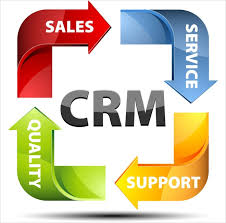 CRM stands for “Customer Relationship Management.” It’s all about getting to know your customers and using this knowledge to form profitable relationships with them. CRM has been around in various forms as long as there have been vendors and customers.
CRM stands for “Customer Relationship Management.” It’s all about getting to know your customers and using this knowledge to form profitable relationships with them. CRM has been around in various forms as long as there have been vendors and customers.
Modern CRM originated in large marketing companies from systems that served two separate areas — sales force automation and call center management. The sales force needed information about customers so it could sell the company’s products. Call centers needed information about customers so they could handle enquiries and resolve problems.
Although usually separate departments with independent functions and management both areas required access to the same customer information. The original CRM systems simply captured, stored and allowed them to access to this information.
These systems were never envisaged as being there to drive the organizationïon’s relationship with its customers. But CRM evolved and as it did so it became increasingly focused on this crucial area.
CRM guru Randy Harris says that CRM has gone through three phases of evolution and is now entering its fourth phase. The first three were technology, integration and process.
Phase 1: Technology — the automation of what had previously been handled manually, including the customer database and customer communications.
Phase 2: Integration — organizations start to direct their operations toward providing customer satisfaction and create links between various operating sections that share information and facilitate customer service.
Phase 3: Process — organizations begin to restructure themselves around their customer relationships, rating their efficiency on the degree of customer satisfaction created. This is the current phase of CRM.
Now that we’ve reached stage three the CRM systems that are in use are automated, highly-refined structures. Most of them however are based on assumptions that are increasingly proving to be doubtful.
For many years it was assumed that past customer behavior could be used to predict future customer behavior, that traditional value propositions would remain in place forever, and that just by improving customer relationships we could ensure customer retention.
But in recent years these assumptions have become victims of the increasing application and success of better and more effective CRM systems.
We’ve found that the behavior of customers changes rapidly as markets create new purchase opportunities and as alternative means of obtaining satisfaction arise. Value propositions have changed significantly as competition across all markets has increased, and every customer relationship is susceptible to better solutions.
Unless we really know our customers – more than just what will influence them to make a purchase, we risk creating organizations that are incapable of achieving optimum profitability because they don’t or can’t because of their structure deliver what the customer really wants.
The fourth phase of CRM that we’re now entering is called “customer-driven CRM.” Customer-driven CRM systems require a business to first understand its customers, then to design systems and infrastructure that will provide them with exceptional and satisfying experiences both during and after purchase.
Customer-driven CRM looks for answers to some very important questions:
— What will our customers buy?
— When will our customers buy?
— What will make our customers buy?
— ïHow much will our customers pay?
— What creates value for them, and if we create value will this bond them to us?
Once it has the answers to these questions the business actually re-invents itself to provide everything that will acquire customers and r etain them. If over time the answers to the questions change, the business will change as well. In effect, the customer determines the structure and systems of the business.
etain them. If over time the answers to the questions change, the business will change as well. In effect, the customer determines the structure and systems of the business.
To enable this to happen CRM software will continue to evolve, particularly by more integration of a business’ communications channels, and by strengthening links to all sources of information within the organization.
There will be a much greater emphasis on long-term partnerships between CRM developers and their clients. CRM systems will be designed to grow as the business grows rather than requiring replacement of CRM systems at regular intervals.
In the longer term it’s likely that a business will restructure itself around its CRM system as the system evolves, reducing the time needed to create effective and more profitable responses to the growing amount and quality of customer information available for analysis.
Copyright 2005, RAN ONE Inc. All rights reserved. Reprinted with permission from www.ranone.com

 Chris’ combination of academic credentials, career experience and temperament ideally suit his calling as a business development advisor. Clients say he has a mind for business and a heart for service.
Chris’ combination of academic credentials, career experience and temperament ideally suit his calling as a business development advisor. Clients say he has a mind for business and a heart for service.